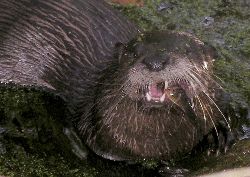 otter
otter
Considering our tendency to think more highly of our close relatives than distant, one would think that we would spend far more time and resources getting to know the group to which we belong. In fact, zoo visitors do tend to congregate to see the big and impressive animals, which all happen to be mammals. Many people are most fascinated with our closest related species: the great apes. So are the mammals in zoos that much more interesting than those that live with us? There is certainly more variety. Besides domesticated species, it is possible to count on the fingers of one hand the kinds of mammals that we see on a day-to-day basis. There are squirrels and... more squirrels. If we live in an area with better habitat, we might see rabbits, armadillos and deer. In cities, there are rats. If we leave food out at night, we will see raccoons and opossums. We're already getting into the "occasional sightings" category. On the other hand, if we were to pay attention to the birds on any ordinary trip to the grocery store, we'd more often than not see pigeons, grackles, starlings, sparrows, mockingbirds, and numerous other song birds. Along any coastline, there would be gulls, pelicans, and other water birds.
Perhaps because they don't happen every day, mammal sightings do tend to be exciting and memorable. On my morning walks, while I like to see the birds and watch their flight or listen to their calls, it always seems more special when I happen to catch a glimpse of a fox, coyote, skunk, or mouse. None of these are particularly rare, but they don't run about in the open all day either. When I was growing up in Illinois, we often hiked in wooded areas or fields. Whenever we found a board or piece of sheet metal lying on the ground, we'd lift it to see what was underneath. Often, we found mice, voles, and shrews. Sometimes they had nests with babies. Here in the South, that kind of discovery is much less likely. Most of the time, if I pick up the same sort of debris, I'll simply find a scorpion or fire ants. When I travel in coastal areas, the spectacular birds are almost taken for granted, but a sighting of an otter or mink is memorable. In fact, whale watching is perhaps the one inroad that mammals have made into the realm of birds as a spectator sport.
Since I got my digital camera, which is small enough to carry with me on walks, I've been able to record a few of my close mammalian encounters. Here is a selection:
 otter
otter
While traveling along the Tamiami Trail at the northern end of the Everglades, I had the chance to stop and explore a boardwalk in the Big Cypress Preserve. As with many nature walks, this one had little descriptive trail signs to provide visitors with more information about the animals and plants they might see. As I passed the one featuring a picture and description of an otter, I heard a loud crunching noise. I'd encountered this before while kayaking and immediately recognized the sound of an otter chewing up a fish. They are very noisy eaters. By bending down and peering between the branches into the nearby creek, I could barely see the otter, keeping one eye on me while brazenly chomping up its catch.
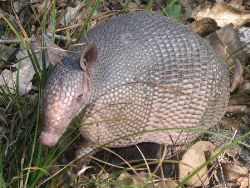
armadillo
Anyone who hikes very much in the South has probably come face to face with armadillos. They have poor eyesight and usually cannot hear much because they are so busy shuffling about in the leaves and dirt, searching for edible morsels. They might suspect somebody is around and stop to sniff, but often they just go about their business, oblivious to onlookers. I met this particular animal in the Silver River State Park in Florida. It showed only slight concern that it might not be alone.
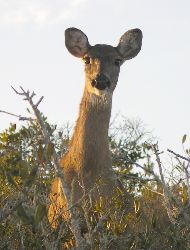
deer
Although deer encounters are not all that rare, especially here in Austin, Texas, this one was rather unexpected. I was hiking in the St. Joseph Peninsula State Park in Florida's panhandle one evening, mainly watching the wading birds as they fed in the shallow waters of the bay. When I turned around, the deer was watching me. It had come up so silently that I was unaware of it, even though there was little ambient noise to cover its arrival. The deer in the park are only moderately accustomed to people, and they avoid the campground and beach areas, so this one's curiosity was amusingly surprising.
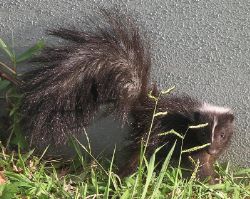
skunk
As with many mammals that are mainly active at night, the best chance for sightings are at dawn and dusk. Skunks are very common in most urban areas, but they retreat to dens during the day and forage only at night. I found this very young and inexperienced skunk behind a shopping center here in Austin early one morning. It had probably only recently left the protection of its mother and had not yet learned to hide before daylight could reveal it. With the number of owls and hawks in the area, it had much more to fear than just a morning hiker.
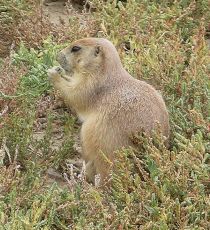
prairie dog
On a recent trip to Denver, Colorado, I visited the Butterfly Pavilion, located on the outskirts of the city. There was a large meadow area with a trail (complete with signs identifying the wild plants) adjoining the building and its surrounding gardens. Just beyond was a hike-n-bike trail, as I could see people jogging past in the distance. The open and weedy field was quite lovely and it made for a pleasant stroll, but then I noticed the dirt mounds strewn about. They sure looked like prairie dog holes, but it was several minutes before I finally saw a head above the vegetation. As I stood still and watched, a pair of prairie dogs foraged within a couple yards of me. It was quite a surprise when all I thought I would see there were wildflowers.

red bat
Bats are the second most species numerous mammals after rodents. However, we rarely see them except as they fly through the dim light of evening or when they are stuck in buildings. This unfortunate bat was found flopping about in the leaves on the ground. It was obviously sick or injured, but could still bare its teeth at threats. It was found in the winter, when some of our bat species, such as the famous Congress Bridge colony of Mexican free-tail bats, have migrated further south. This is an eastern red bat, which is a solitary species.

least shrew
While hiking at Hornsby Bend one day, I happened to turn over a piece of sheet metal that was lying on the ground. I caught a glimpse of a shrew as it dove down one of its tunnels amidst several shallow runways in the soil. There was also a small grass-lined nest. Knowing that shrews have a very short time tolerance for anything, all I had to do was wait for a few seconds before it came back up to see what was going on. Shrews live life in the fast lane, with super-speed metabolisms and life spans that top out at two years. Hence, they have no patience and won't hide for long. This one kept going down into a tunnel with two entrances and coming up in alternating sides. I managed to photograph it by timing when and where its next appearance would be.